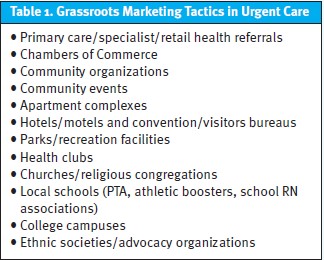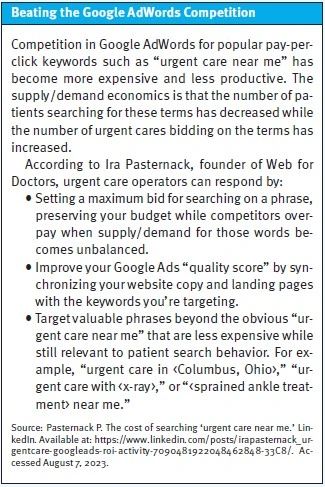Heather Real
Download the article PDF: Is It Time to Revisit Your Urgent Care Marketing Tactics?
In the journey of an urgent care visit, where does the patient story begin? Is it when the patient walks through the door, or did it start when the patient was still at home Googling “urgent care near me” on their phone?
It is likely neither of these. The patient journey to your urgent care actually begins before they even have a sniffle, fever, or injury; their journey began the first time they saw your urgent care sign while going about their regular day, moving between home, work, school, groceries, activities, and errands. Every time they pass by and see your bright sign and the lights on, they are reminded you and your staff are there, ready to take care of them when they need you. They may check your website for your hours or, better yet, an online queueing and registration option, but they likely knew where they wanted to go before they opened their browser.
In today’s digital world, driven by “likes,” clicks, and ratings, the most powerful piece of marketing is still likely going to be your street-visible signage and positive word-of-mouth. This doesn’t mean we should dump the digital; rather, diversify your strategy across digital, community, and print marketing.
Over the last 3 years, a lot of urgent cares essentially shifted to a “mostly COVID” operating model, managing hundreds of tests per day. The patient’s journey to their medical destination also shifted. Prepandemic, patients would generally utilize the urgent care most familiar to them, nearby with hours and services that consistently met their needs and where they’ve had previous positive patient experiences. During the pandemic, patient choice may have been driven by “time slot” availability that coincided with their needs for a test, soonest available and/or shortest published wait times, which center provides test results faster, or even, where they can use a patient portal for test results rather than wait by the phone.
In response to this changing consumer behavior, many urgent care businesses launched or optimized online patient queueing systems to match the flow of patients to provider capacity and thus reduce on-site wait times. With the addition of other functionality like self-registration, our own patients became one of the most effective resources in enhancing workflows and efficiencies during these high-volume periods.
By maintaining these functions and encouraging utilization, we can retain some control over the patient flow to our centers. Looking forward to a potentially “normal” cold and flu season, patients and staff will appreciate the wait time transparency, as patients will prefer to wait in the comfort of their own home, rather than in overcrowded waiting rooms.
Now that you have a queuing system, are you making your next available appointment times visible to search engines? Integration between Google and your center’s queueing system will provide real-time wait times in Google search results, enabling someone looking for your urgent care to grab the next available slot while still on the Google page.
In addition to reducing staff time on data entry, having patients complete their own registration is likely to reduce errors that can delay insurance payments. Promoting this functionality and the “pick your time” experience will resonate with patients as the waiting rooms fill up this fall.
Prior to the pandemic, as an industry we promoted “grassroots” marketing. Not only was mass media advertising cost prohibitive to a single center operator in a 6- to 8-million-person market like Chicago or Houston, but such also provided “face-to-face” interactions to build trust and spur positive word of mouth. The pandemic, however, shut those venues down and forced nearly all marketing to go digital. The need for widespread, efficient, and convenient COVID-19 testing certainly boosted patient awareness and utilization of urgent care as a place of service. As urgent care poured more money into Google AdWords for “COVID test near me,” increased demand resulted in a cost increase for these pay-per-click services, yet yielded a diminished return due to the inflated utilization.
Rather than leaning into the highly competitive web marketing wars, maybe now is the perfect time to revive those community-based efforts that had previously been the strongest channels for winning patient loyalty. While emerging technologies improve the patient experience and overall center operations, urgent care businesses have historically thrived on hyper-local, grassroots marketing. By blending what we’ve learned from our digital efforts and what we’ve taught our patients along the way, we can bring a fresh, multifaceted approach to our marketing strategies.
The best way to promote your business is by meeting the patients where they are. Connecting with organizations that are grounded in your community will go a long way in gaining local loyalty. In many communities, this means partnering with school districts and athletic departments, as well as supporting other community events such as 5K runs, health and safety fairs, church and Chamber of Commerce events, and more. Promoting school, sports, and camp physicals is a great way to bring new patients to your center during the typically slower summer months and, hopefully, bring those patients back later in the season when they get sick or injured. (See Table 1.) Get out and meet the school nurses and athletic directors in your community. When parents and kids “try” you with a good experience, positive word-of-mouth will follow. That kind of advertisement can’t be bought and is the most influential in bringing new patients to your door.

It’s important to remember where that patient journey begins: before they need you and the services you offer. The combination of grassroots and digital marketing efforts through social media can be a highly effective way to reach a lot of patients with very little spend. Thinking beyond those “health-ful” tips that get posted to Facebook once a week/month/quarter and service offerings, you might use social media to engage people outside of urgent care needs and offerings. You can use social media to initiate interactive activities like community-wide scavenger hunts, trivia contests, or fundraising events for a family or nonprofit in need. Introduce your staff, highlight when patients and staff go above and beyond in service, as well as expressions of gratitude. These are great ways to deepen your roots in the community and gain patient loyalty.
As you prepare for whatever this year’s cold-and-flu season brings, think about all the ways you can diversify your marketing efforts to reach more patients and raise awareness of your services. Leverage the tools you are already using to extend the patient experience beyond your front doors and before the urgent care is needed.

Read More
- If Your Business Doesn’t Work On Paper, It Won’t Work In Reality!
- A Return On Investment Approach To Urgent Care Marketing

